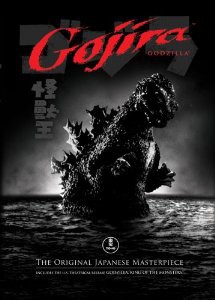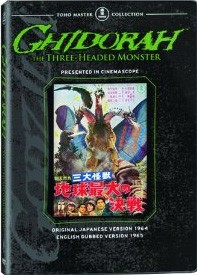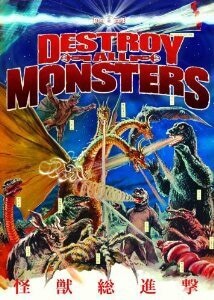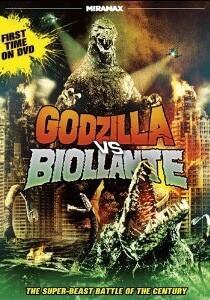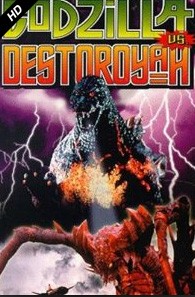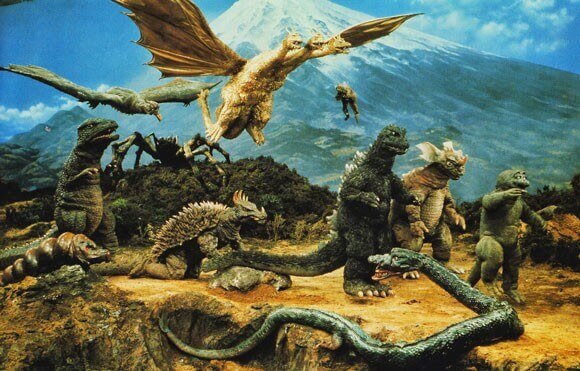
Godzilla is one of the longest running (60 years and 29 films at the moment) and most successful film franchises of all time. Big G is an iconic monster whose suffix – “zilla” – has come to be a universal add-on to anything that’s just too big to be believed. Since Godzilla was played by a man in a suit/costume, he had from the very beginning a very distinct and engaging personality. No CGI here and these practical effects helped breathe life into this kaiju (a Japanese word that translates as “strange creature”). Godzilla was a force of nature that could not be controlled or destroyed. He was also like the schoolyard bully that could stomp on Tokyo whenever he felt like it but could also channeled his aggression toward any other creature – often Ghidorah – that dared to invade his turf.
But whether raging monster or reluctant hero, Godzilla was always a force to be reckoned with and a monster with a distinct personality, which is one of the reasons he has endured for so long. People love these movies because of Godzilla, because of who he is and how he has changed over the years. He is a star as great as anyone Hollywood has produced and his fan club is worldwide and across generations.
Narrowing down the Godzilla canon to a mere 10 best films is nearly impossible for a fan who loves them all, even the flawed ones. (The worst one, however, is easy to pick: the 1998 American remake that all true Godzilla fans simply pretend never existed.) So instead of a 10 best list here’s a list of the 10 most important films to see to understand Godzilla’s origin, legacy, and mythology. Consider this your Godzilla primer in preparation for Gareth Edwards’ 2014 Toho-licensed but non-Japanese made Godzilla.
The Godzilla films are generally broken into three eras reflecting different styles. The first two eras reflect the imperial reign of the time and are the Showa era (1954–1975), and the Heisei era (1984–1995). The third is the Millennium era spanning (1999-2004).
So here you go!
1. Gojira (1954)
Directed by Ishiro Honda; effects by Eiji Tsuburaya
Godzilla suit actors: Haruo Nakajima, Katsumi Tezuka
This first film is Godzilla’s origin film, and it’s an absolute must to start here. I urge that you seek out the 60th-anniversary version from Rialto for not only a gorgeous restoration and transfer but also for the wonderful new subtitles that convey better nuance in the dialogue as well as offer translation of all the newspaper headlines and assorted other onscreen text. If you’ve only seen the U.S. butchered version – in which Raymond Burr was inserted into the Japanese film and huge chunks of the original film chopped out – then you’ve never seen Godzilla.
In his 1954 debut movie, Godzilla is born out of an atomic blast that wakes him from the ocean depths. But he also rose out of real-life tragedies that hit his homeland of Japan. Not only was he the symbolic representation of the two atomic bombs dropped on Japan but also of a 1954 incident involving a Japanese fishing vessel exposed to fallout from a test explosion of a U.S. hydrogen bomb detonated at Bikini Atoll. Japan was still recovering from the devastation of the two atomic bombs, so this additional nuclear tragedy prompted renewed public outcry, and Godzilla served up an immediate response and outlet for fears.
In the original Japanese version of the film, the destruction Godzilla leaves in his wake looks shockingly similar to the ruins found in Hiroshima and Nagasaki. The film, unlike literary works, was able to provide a visualization of what had previously been unimaginable destruction. Godzilla – a giant monster that’s extraordinary — became the perfect way of representing an experience that is absolutely not ordinary. Through science fiction, Japanese filmmakers have the opportunity to make the unimaginable more tangible and therefore allow people to confront their fears.
Godzilla also allowed Japanese filmgoers to wrestle with their ambivalence about science and nuclear technology in particular. There can be both positive and negative applications of technology as Dr. Serizawa reveals in the first film. He created the oxygen destroyer, the device that kills Godzilla in the first film and was initially invented for positive purposes. He wanted it to benefit mankind but then that device got turned into something terrifyingly destructive, which is why he decided to die with Godzilla and the device he created. Japan was devastated by atomic bombs and therefore had a sense of caution about nuclear technology. Yet Japan would also develop into a country that would rely heavily on nuclear energy.
So this first film began a dialogue about nuclear technology that has proven a long and complex one for Japan and set the tone for the underlying seriousness of this fantastical franchise. The social commentary, though, never got in the way of the pure entertainment value of these amazing films.
2. Mothra Vs. Godzilla/Godzilla Vs. The Thing (1964)
Directed by Ishiro Honda; effects by Eiji Tsuburaya
Godzilla suit actors: Haruo Nakajima, Katsumi Tezuka
This is the fourth film in the Godzilla franchise and is significant for being the first time Toho brought in kaiju from other movies to join or oppose Big G. Mothra first appeared outside the Godzilla universe in a 1961 film that’s a must-see for the kaiju genre. This film, however, marks the first time Mothra appears with Godzilla. In the U.S. the film was marketed as Godzilla Vs. The Thing in “eye-jolting color and terror-scope!” The monster was made a mystery for the U.S. release perhaps because American distributors felt a giant moth just wasn’t terrifying enough.
This divine moth comes with a pair of tiny twin fairies or priestesses known as the Shobijin (played in the first three Mothra films by The Peanuts, a Japanese pop vocal group made up of twin sisters Emi and Yumi Itō) that can communicate through telepathy with Mothra. Mothra, a female kaiju from Infant Island (in the first film it was called Mothra Island), is generally seen as kind and benevolent, always trying to save the earth with a minimal amount of destruction. In Mothra Vs. Godzilla, she shows her maternal instincts, protecting her eggs till death. It’s her twin larvae in the film that ultimately fight and defeat Godzilla by wrapping him with their cocoon spray and pushing him into the ocean.
3. Ghidorah, The Three-Headed Monster (1964)
Directed by Ishiro Honda; effects by Eiji Tsuburaya
Godzilla suit actors: Haruo Nakajima, Katsumi Tezuka
This fifth film is key in the Godzilla franchise because not only does it introduce Godzilla’s key nemesis, King Ghidorah, but it also marks a turning point as Big G starts to have a change of heart. He might be a bully stomping Japan but dammit it’s his turf, and he sure isn’t about to let anyone else trample it, so he agrees (not easily though) to fight against Ghidorah to save the earth.
There’s no shortage of monsters here as Mothra wrangles enemies Godzilla and Rodan into fighting for humanity against the invading evil space monster Ghidorah. Mothra’s negotiations, though, are quite entertaining. Mothra arrives during an extended battle between Rodan and Godzilla. The two display some schoolyard antics as they fight, tossing rocks back and forth like a volleyball or kicking them as if in a soccer match. Rodan pecks Godzilla on the head and taunts him with derisive laughter as Mothra watches. Mothra’s female sense of cooperation prompts her to try and convince the boys to stop fighting and help earth.
There’s some classic dialogue here as when a man is asked what the monsters are saying, and he replies, “Don’t ask me, I never studied monster languages.” Fortunately, the Twins have, and they translate what Mothra’s saying. She says, “Don’t fight. Let’s work together to protect the earth from King Ghidorah’s violence.” But the boys say they don’t care. Godzilla even complains that humans are always “bullying” him so why should he save them? This prompts one observer to note: “Men are not the only stubborn creatures.”
And here’s where a little political commentary comes into play. The scene entertainingly suggests what real-life political negotiations can be like with different factions acting childish and not wanting to work together. At this time, Japan saw a new threat arising from China, which had recently exploded its first atomic bomb announcing its entrance into the ranks of the superpowers. Ghidorah even looks like the Chinese dragon of mythology and became the perfect symbol for the threat Japan saw in China.
Also noteworthy here is Big G’s fighting style. He demonstrates some of the boxing stylings of America’s 1933 King Kong thanks to Haruo Nakajima’s inspired suit acting.
4. Monster Zero (1965)
Directed by Ishiro Honda; effects by Eiji Tsuburaya
Godzilla suit actor: Haruo Nakajima
Ghidorah proved so popular that he made an immediate return in Monster Zero. With the opening shot of a spaceship, the film announced a more clearly defined sci-fi tone. The film boasts American actor Nick Adams, hot space chicks from Planet X, awesome alien costumes and shades, and of course Godzilla’s famous (or to some infamous) celebratory jig. One thing that’s remarkable is that the trailers reveal all the monsters. There’s no secrecy, no holding back, no hiding them till later or mere teasing the audience with obscure imagery. No way. Because the monsters ARE the stars. They ARE what draws the audience in.
Godzilla and Rodan team up to once again take on Ghidorah after some aliens offer a cure for cancer in exchange for mankind’s help in getting Big G and Rodan to fight Ghidorah. So Godzilla and Rodan get transported in giant space bubbles to Planet X. Godzilla, once again performed by Nakajima, displays some fancy footwork, and Kumi Mizuno provides eye candy as the alien girl Namikawa.
5. Destroy All Monsters (1968)
Directed by Ishiro Honda; effects by Sadamasa Arikawa with Eiji Tsuburaya serving as supervisor
Godzilla suit actor: Haruo Nakajima
“From outer space comes the order: Monsters attack. Godzilla paralyzes NY. Rodan ravages Moscow. Mothra massacres Peking. Baragon terrorizes Paris. Massive armies versus mad monsters for possession of planet earth.” The U.S. trailer for Destroy All Monsters sounds like a travelogue of kaiju destruction. The film included more sci-fi elements and more hot space babes. It also spawned an Atari video game.
This film is notable for two main reasons. First the embarrassment of riches in the kaiju department with a veritable who’s who of monsters on hand: Anguirus, Baragon, Gorosaurus, King Ghidorah, Kumonga, Manda, Minilla, Mothra, Rodan, and Varan all coming out to play. And second, you have to see at least one film with Minya, the Barney-like baby Godzilla, so you can understand what all the fan outrage and debate is about. Some can’t stand him or his character design, while others defend him as a product of his times. He first appeared in Son of Godzilla but this is the better film to catch a glimpse of this goofball kaiju.
Favorite title in the credits: “Goro Naya as voice of Nick Adams.”
6. Godzilla Vs. Hedorah (1967)
Directed by Yoshimitsu Banno; effects by Teruyoshi Nakano
Godzilla suit actor: Haruo Nakajima
Know this before you watch: This film, like the character of Minya, is incredibly divisive and often puts fans firmly in one camp or the other. The film had a smaller budget and shorter shooting schedule to work with than earlier films and a new director. From the very first opening note of music in this film you know you are in for a tonal shift in the franchise. There is no longer Godzilla’s dignified and majestic theme music to start us off but rather a cartoonish wah-wah-sounding score to announce the king of the monsters in what some considered a rather mortifying manner.
After an opening song, the film cuts to a small child playing with Godzilla toys and that perfectly sums up who the film was targeting and why. The focus on young audiences and what could be marketed to them is further emphasized in the animated cartoon segments of the film. The film also reflects the ’70s with its flights of psychedelic fancy, protests, acid rock concerts, environmental awareness, and bad fashion.
The film arrived the same year as the Torrey Canyon supertanker spill off the coast of England (one of the worst in history) and reflected how oil spills had became a major concern in 1960s. Godzilla’s nemesis in the film is Hedorah, a monster born out of the sludge of pollution. The opening montage shows horrific images of pollution that might have been inspired by the rising awareness of the effects pollution was having on the population.
During the ’60s in Japan, emissions of nitrogen dioxide, carbon monoxide, and sulfur dioxide had tripled, and pollution-related illnesses such as Yokkaichi asthma and Minamata disease (mercury poisoning) were named after the Japanese cities where they first appeared. So once again, Godzilla became the means of channeling fears about real-life horrors, and as the little boy says, “Godzilla would be upset if he saw all the pollution.”
Godzilla Vs. Hedorah is also noteworthy as the only film in which Godzilla flies. He seems to blow a variation of his atomic breath to get into the air, and he flies in a kind of backward manner with his tail curled up toward him. This would have been a very helpful ability in his battles against the airborne Mothra, Rodan, and Ghidorah.
7. Godzilla vs. Biollante (1989)
Directed by Kazuki Omori; effects by Koichi Kawakita
Godzilla suit actor: Kenpachiro Satsuma
If environmental awareness was the faddish concern of the ’70s, cloning and gene splicing and any scientific research involving man messing with nature and DNA to produce clones or mutations were the hot button issues of the ’80s. The film predates Dolly, the famously cloned sheep by seven years, but it comes five years after Danish scientist Steen Willadsen gave us the first confirmed case of mammalian cloning using a method called nuclear transfer. The film bridges the two decades with its notion of anti-nuclear energy bacteria that can eat nuclear waste. One scientist points out that Americans created bacteria to eat oil from an oil spill so perhaps the concept could work on Godzilla since he feeds on nuclear energy.
This time out it’s Godzilla’s cells from his supposedly dead body that are the catalyst for trouble. There’s ESP, a girl who talks to plants, and a kind of kaiju version of Audrey II from Little Shop of Horrors. A scientist creates nuclear-digesting genes and splices them with plant cells but oops! He makes them self-replicating and before we know it there’s Biollante. The massive plant creature first appears in silhouette and it looks remarkably Godzilla-shaped at first glance, but on closer inspection we notice the plant-like limbs and floral head. Later we are told that Godzilla and Biollante are not like a brother and sister from the same family but rather identical creatures. Well sort of. Biollante spits some acidic like yellowish goo and is multi-tentacled (or would that be vined?) with nasty, tooth-filled heads on each vine-y limb.
Biollante contains the spirit of the scientist’s daughter and he concludes that Biollante and Godzilla aren’t the monsters, it’s the arrogant scientists that create them. Again the complex notion of science being both good and bad arises here, and there’s irony in the fact that something taken from Godzilla’s cells could be made into something to destroy him.
In a voiceover at the end, we hear the daughter’s voice read the following lines: “How long have we been living in such an age? Maybe it started when man first stepped out of the Garden of Eden, and left his innocence behind. Man would do well to remember this day, forever.”
The scientist says the name he christens Biollante with comes from Norse mythology. There’s a great scene where all the kids dream of Godzilla and draw him in class.
8. Godzilla vs. Ghidorah (1991)
Directed by Kazuki Omori; effects by Koichi Kawakita
Godzilla suit actor: Kenpachiro Satsuma
Biollante, a newly created kaiju, didn’t fare all that well at the box office so for the ’90s reboot of the franchise, Toho went back to proven veterans so fan favorites Mothra and Ghidorah were brought back. And these ’90s films really delivered, raising the level of effects to a new level. Godzilla’s rematch with Ghidorah came first and Mothra a year later. Either film provides a good introduction to the newer Godzilla films. Ghidorah, though, is good for its mecha element as Ghidorah is brought back and equipped with new mechanical wings and head. The effects work is quite impressive and Japan suffers some major destruction under the delicate feet of these giant monsters.
9. Destroyah (1995)
Directed by Takao Okawara; effects by Koichi Kawakita
Godzilla suit actor: Kenpachiro Satsuma
Okay, this one still makes me cry. It’s as bad as King Kong in terms of making me well up. I don’t cry for much but when my beloved monsters die in particularly cruel fashion, well it hurts. In the past, Godzilla might “die” at the end but you always felt that he would return. Here a girl seriously notes, “I fear this will be Godzilla’s last fight.” And so do we. It’s hard to think Godzilla can return from…
****SPOILER ALERT***
…full meltdown with flesh dripping off his bones. So although this film made my son and I weep, you cannot avoid seeing Godzilla’s nuclear meltdown and battle with Destroyah. The fears expressed back in this 1995 film have proven very real concerns for Japan in light of the 2011 tsunami that wrecked the Fukushima Daiichi nuclear power plant.
This film returns Godzilla to very strong nuclear images with Godzilla himself described as having a “heart” akin to a nuclear reactor and in this film he’s actually experiencing a meltdown with nuclear fission apparently taking place inside his body. There are scenes from the original Godzilla film included here and Momoko Kōchi reprises her role as Emiko to remind us of the horrors of the oxygen destroyer that put the first Godzilla to rest. Godzilla’s meltdown is truly horrific and symbolic of what a real nuclear meltdown might be like. The film ends with this thought regarding all the destruction: “I guess we paid for it… paid for all that stupid use of nuclear energy.” This film feels like a perfect bookend with the original Gojira for summing up what the Godzilla legacy is all about.
This film is notable for a few other items. The introduction of Junior, a new and for many, better-designed offspring for Big G, and the genuinely tender parental moments between Godzilla and Junior (get out your Kleenex). One character even notes that Godzilla was crying over the injuries to his family. It’s also impressive to see the size of Destroyah. I wish there were an IMAX version of this film.
10. Godzilla, Mothra, and King Ghidorah: Giant Monster All-Out Attack or GMK (2001)
Directed by Shusuke Kaneko; effects by Makoto Kamiya
Godzilla suit actor: Mizuho Yoshida
But even though Godzilla seemed truly destroyed, there was a mere four-year break before he returned in a new incarnation for the new millennium and the must-see of the Millennium series has to be Godzilla, Mothra, and King Ghidorah: Giant Monster All-Out Attack if only for all the monsters gathered together, it’s like a monster convention with monsters attacking by land, air, and sea.
The atomic bomb imagery is here again with flashes of white light, mushroom clouds, and a teacher looking out in terror at the destruction and exclaiming, “Atom bomb.” This film has one of the best slow reveals of Godzilla – first a quick glimpse of spines in the depths of the ocean, then an extreme low angle revealing him in all his towering glory. There’s a burrowing Baragon and play-by-play announcing from TV reporters as the monsters go at it. For a change, Mothra shoots stingers from her abdomen rather than having her magic web-shooting and Godzilla has creepy white eyes. One of the memorable moments involves a young injured girl in a hospital room. In terror she watches Godzilla pass by the hospital and just as she breathes a sigh of relief at his passing, his tail comes whipping around moments later and levels the building. Like nature, Godzilla can sometimes be carelessly cruel.
Through dozens of movies spanning more than half a century Godzilla has transformed from being the monster attacking Tokyo to the one sometimes defending it. He emerged from the fears and anxiety over nuclear weapons but has come to represent a much more complex message about finding a balance between science and nature, and between technology and the dangers it poses. These ten films provide an introduction to Toho’s Godzilla franchise and its iconic monster star. Enjoy!

